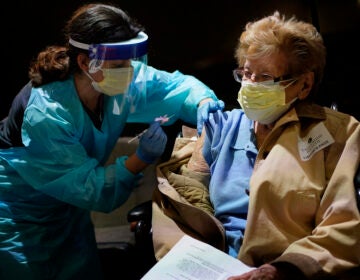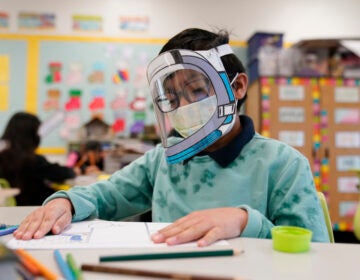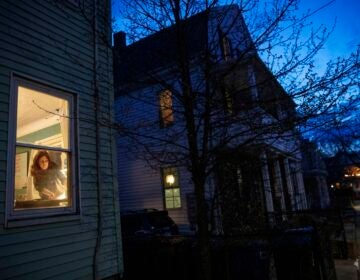How pharmacies and labs are scrambling to manage loss of federal COVID funds
Testing sites have had to turn people away now that they can’t bill the federal government. Vaccinators are bracing for a similar fate.
Listen 3:12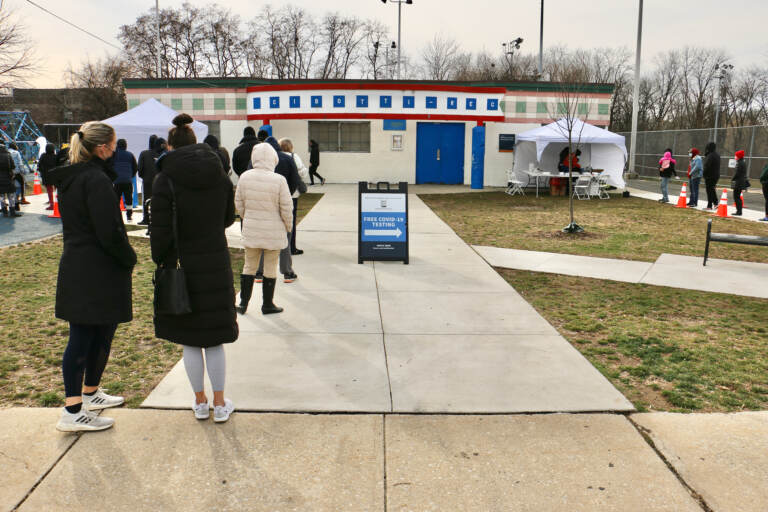
People line up for free COVID-19 tests outside Cibotti Recreation Center in Southwest Philadelphia. (Emma Lee/WHYY)
The COVID-19 pandemic has changed everything. What should we know about how you approach the world now? How has the pandemic changed your social life, your work life, your interactions with your neighbors? Get in touch here.
This is one of a series of articles in which reporters from WHYY’s Health Desk Help Desk answer questions about vaccines and COVID-19 submitted by you, our audience.
Elissa Devenny is at a crossroads. When the federal program she’s been using to cover her costs for vaccinating uninsured patients dries up on April 6, her small pharmacy in West Philadelphia will have to do one of two things:
Find a way to pay for those vaccinations, or stop vaccinating altogether.
“We don’t have an exact plan yet,” said Devenny, who is the pharmacy manager at a SunRay Drugs location. “It’s definitely going to make a huge impact.”
The COVID-19 vaccines themselves are completely free to all Americans, and they’ll stay that way when the program funding runs out on April 6. But administering the doses does cost money. Pharmacies need to pay the people who administer the shots. If patients have private insurance, or are on a publicly funded program like Medicaid or Medicare, pharmacies or other vaccine providers bill those agencies to be reimbursed for the cost of providing the shots.
If the patients are uninsured, like 70% of those Devenny’s pharmacy vaccinates, the pharmacy can bill the Health Resources and Services Administration, or HRSA. But that money will be no longer available come April 6.
“We don’t want to stop offering vaccines, but at the same time, if we can’t pay a pharmacist to be at clinics, it makes it a little more difficult,” Devenny said.
SunRay is still running two vaccine clinics a week, she said: one at Drexel University, and one in Chinatown. At one clinic last week, they vaccinated 40 people; the majority of patients being vaccinated at the clinics are uninsured. Though SunRay might be able to continue vaccinating walk-ins at the pharmacies themselves, Devenny said she is doubtful they’d be able to continue doing the more proactive outreach, since staffing costs would be difficult to cover.
The same is true for Lindsay Dymowski, who along with her family runs Centennial Pharmacy in Philadelphia. Dymowsky’s business model has depended heavily on the HRSA funds to do outreach within the community — throughout the pandemic, Centennial has partnered with hotels and restaurants to vaccinate their staff members, many of whom were uninsured or undocumented.
Dymowski said Centennial wouldn’t be able to pay for a pharmacist team to go out and do that if it hadn’t been able to be reimbursed by the federal government. She acknowledged that demand for vaccines is low now, but if another booster is authorized or cases rise, that could easily shift.
“That is when those who are uninsured, underinsured, or undocumented are going to be affected the most,” she said.
When the funding runs out, however, the federal requirement to offer a COVID-19 vaccine for no out-of-pocket cost to the patient will remain. That means smaller providers with large numbers of uninsured patients, like SunRay and Centennial, will need to determine whether they can find a way to cover the costs, or stop offering shots completely.
Trinity Health Mid-Atlantic — which includes Mercy Fitzgerald Hospital in Darby, Nazareth Hospital in Philadelphia, and St. Francis Hospital in Wilmington — will keep vaccinating and testing uninsured patients. If they cannot help the uninsured patients enroll in Medicare or Medicaid or some other kind of insurance, which they do routinely, the system will cover the cost of vaccinating or testing those people, said chief clinical officer Sharon Carney.
The money is disappearing because Congress declined to include $22.5 billion in COVID relief in the recent government spending package. It’s unclear whether any sort of stopgap spending will be approved in the coming weeks.
While many are bracing for the end of HRSA’s vaccine reimbursement for the uninsured, those that billed the program for COVID tests are already feeling the pain — that part of the program ended March 22.
The Lab at Seascape, an independent clinical lab in Milford, Delaware, has been doing more than a thousand COVID-19 tests a day throughout the pandemic, for nursing home residents, employees, visitors, and walk-ins. But many of those people are uninsured, so ever since the federal funding for testing uninsured patients went away, the lab is down to doing around 100 tests a day, according to CEO Karen Coverdale. Her team has had to turn people away this week.
“We have to explain to them that the reimbursement is gone,” Coverdale said. “We do … almost a million tests per year, blood tests and COVID testing, but we cannot afford to keep the lights on if we do free testing.”
She said that running and maintaining a certified COVID-19 test site is expensive: It requires hundreds of thousands of dollars worth of lab equipment, chemicals, and protective equipment, as well as well trained staff and regular maintenance.
“We’re spending … easily $100,000 per month on the reagent and the consumables to run the test,” Coverdale said.
Her team is proud to run a testing operation in their area and help people visit nursing homes safely, she said, and going forward, they will add extra instruments so their equipment can run different kinds of tests.
The transition is not easy, said Gulamnabi Vahora, medical director of Skippack Medical Lab in Bristol. He said his operation has hired more than 40 people in the pandemic to keep up with testing demand.
“If I don’t provide work to these people, I will lose those people,” he said.
COVID-19 testing has been the vast majority of their work during the pandemic, and it will take a while to reestablish contact with nursing homes, doctors, and hospitals to go back to the testing they used to do. Vahora said he’s afraid of what could happen if there is another surge and all of a sudden a lot of people need to get tested again.
“[The federal government is] downsizing everything because you don’t have money to pay for it,” he said. “So if we do that, then they will need to build up again [if there is a surge].”
Testing sites associated with bigger health systems are better equipped to scale up and back, depending on the demand. At Temple Health, chief medical officer Tony Reed said the system is moving away from mass testing centers to small testing sites, such as urgent care centers, while demand is low. He also said it’s not as hard to get tests now that people can buy them to take at home, and there are still pop-up test sites in the areas that Temple serves.
Demand for testing has gone down in Camden in the past few weeks as well, said Patricia DeShields, CEO of Project H.O.P.E., a federally qualified health center. She said that’s the case for their site and the other testing sites in their area, including at nearby Cooper University Hospital.
“When we have long lines, they have long lines… now, it’s quiet.”
And that if the situation were to change and more people needed tests again, she said, they would do it regardless of insurance status.
WHYY is your source for fact-based, in-depth journalism and information. As a nonprofit organization, we rely on financial support from readers like you. Please give today.


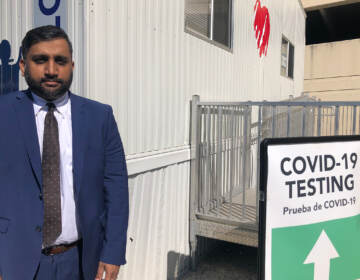
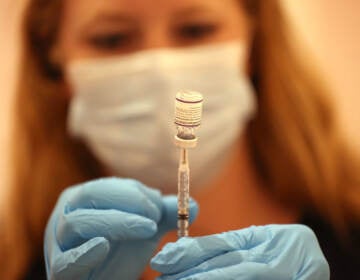

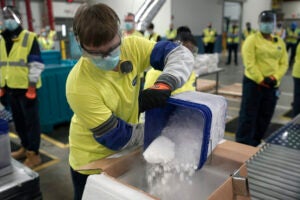
![CoronavirusPandemic_1024x512[1]](https://whyy.org/wp-content/uploads/2020/03/CoronavirusPandemic_1024x5121-300x150.jpg)
